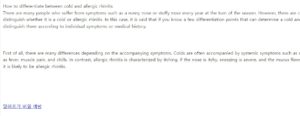How to differentiate between cold and allergic rhinitis
There are many people who suffer from symptoms such as a runny nose or stuffy nose every year at the turn of the season. However, there are cases where it is not easy to distinguish whether it is a cold or allergic rhinitis. In this case, it is said that if you know a few differentiation points that can determine a cold and allergic rhinitis, you can easily distinguish them according to individual symptoms or medical history.
First of all, there are many differences depending on the accompanying symptoms. Colds are often accompanied by systemic symptoms such as sore throat or nose pain, as well as fever, muscle pain, and chills. In contrast, allergic rhinitis is characterized by itching. If the nose is itchy, sneezing is severe, and the mucus flows like water rather than mucus, it is likely to be allergic rhinitis.

About 70% of patients with allergic rhinitis show symptoms of itching in the eyes, watery eyes, conjunctival congestion, and itching in the ears, face, and neck. In addition, it is possible to differentiate between a cold and allergic rhinitis through the duration or recurrence of symptoms. It is rare to catch a cold repeatedly several times, and it is common for it to recover on its own within 1 to 2 weeks. On the other hand, allergic rhinitis often lasts for several weeks or appears chronically for a long period of time, and is characterized by repeated occurrence in specific situations and environments.
How to treat allergic rhinitis
Treatment of allergic rhinitis can be largely divided into environmental management, drug therapy, and immunotherapy. It is said that the main treatment for patients with rhinitis is to administer medication while minimizing exposure to allergens or aggravating factors that cause rhinitis. However, it is known that there are cases in which environmental management or drug treatment alone is not effective enough, and in many cases, it is difficult to discontinue the drug because symptoms recur when drug treatment is stopped.
In this case, it is said that ‘allergy immunotherapy’ is needed to fundamentally improve the allergic constitution. Immunotherapy is a treatment in which a causative allergen is gradually injected from a small amount and maintained at a high concentration for a certain period of time so that the patient no longer reacts sensitively to the causative substance. Currently, there are two treatment methods: subcutaneous injection and self-sublingual administration.
This method can be performed using antigens such as house dust mites, molds, animal hair, and pollen, and is said to be particularly effective in treating pollen allergy. However, it is not applicable to all people, and it is said that a good effect can be expected only when a clear positive reaction to an allergic substance matching the medical history is obtained in a skin test or blood test. In addition, it is said that maintenance treatment is required for at least 3 to 5 years to prevent recurrence, and it is recommended to visit an allergist and consult with an allergist to determine whether you can be a target for immunotherapy.
Allergic diseases to watch out for during the spring season
During the spring season, indoor and air quality is poor due to pollen, fine dust, and yellow dust. Because of this, many people suffer from environmental diseases such as allergic diseases. Spring is the hardest time of the year, especially for those who are allergic to pollen. Mainly, tree pollen causes allergy. Pine pollen, which can be seen as it clumps together, can also be a problem, but most of the pollen is from windblown trees, such as birch, alder, hazel, elm, and cedar, whose particles are small and invisible. is known to cause allergies.
The most common forms of allergic disease caused by pollen are rhinitis and conjunctivitis, in addition to seasonal asthma or chronic cough, atopic dermatitis, contact dermatitis, etc. may also occur. In addition, doctors say that asthma patients should be especially careful because there is a large daily temperature difference and a lot of dust.
Asthma is a disease in which the airways become sensitive due to bronchial inflammation. Cold, dry air and fine dust stimulate the bronchial tubes, and viral diseases such as colds are the most common cause of exacerbating asthma.